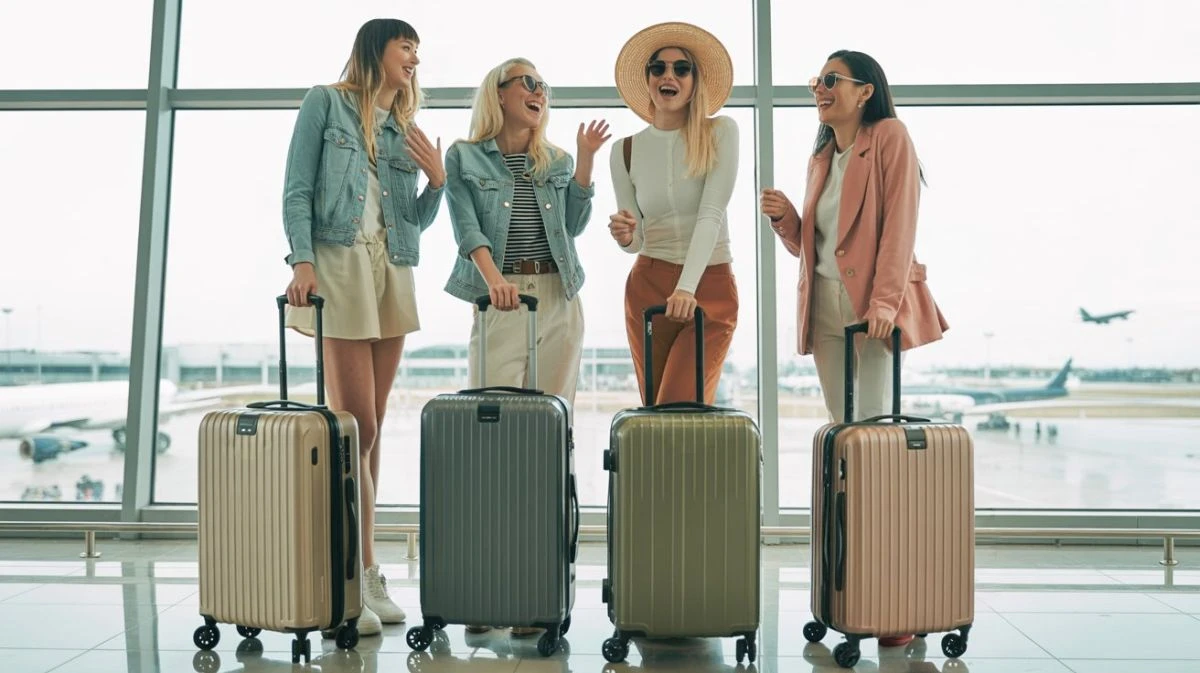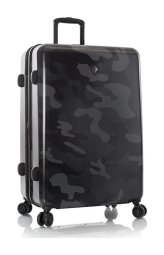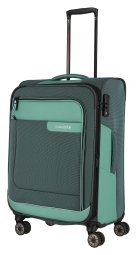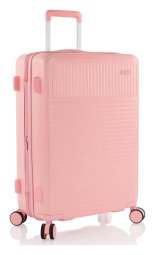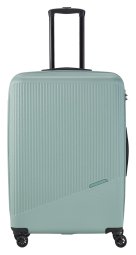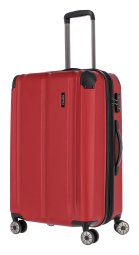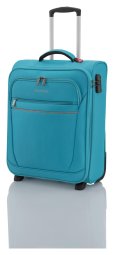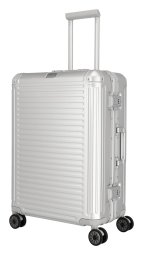Traveling is a joy, and a well-chosen travel suitcase is the foundation for a carefree holiday or a successful business trip. The market offers a plethora of models, but how do you choose a suitcase that will be reliable, protect your belongings, and be easy to handle? We have prepared a complete guide to choosing a travel suitcase for you, which will help you navigate key aspects such as size, material, wheels, and security features.
Contents:
- Clarify Your Travel Needs
- Suitcase Size: The Right Volume is Key
- Suitcase Material: Hardshell vs. Softshell
- Wheels: The Key to Comfortable Handling
- Handles and Grips: Comfortable Grip
- Locks and Security: Protecting Your Property
- Internal Layout and Practical Features
- Design and Color: Show Your Style
- Suitcase Care: Extending its Lifespan
- Frequently Asked Questions (FAQ)
Before You Start Choosing: Clarify Your Travel Needs
Before you dive into the options, think about your travel style. Answering the following questions will help you define what kind of travel suitcase you really need:
- Frequency and duration of travel: Do you travel once a year, or are you constantly on the go? This will affect the demands on durability and size.
- Mode of transport: Do you fly often (emphasis on the dimensions of carry-on luggage and the durability of checked baggage), or do you travel by car/train (more flexibility)?
- Number of travelers: Are you packing just for yourself, or for the whole family? This will help determine the required volume.
- Type of items being transported: Do you need to protect fragile electronics, or do you mostly carry clothes?
- Budget: A quality travel suitcase is an investment. Decide how much you are willing to spend.
Answering these questions is key to guiding your selection process.
Suitcase Size: The Right Luggage Volume is Key
The size of the travel suitcase is crucial. Too small is limiting, and unnecessarily large is impractical and tempting to overpack.
Carry-on Suitcases (Size S / Cabin Luggage)
A Size S suitcase is ideal for short trips (1-3 days), business trips, or as a supplement to large wheeled luggage. You can take it on board the plane, saving you check-in fees.
- Typical dimensions: Around 55 x 40 x 20 cm. Small suitcases are ideal carry-on luggage. But always check your airline's limits! Low-cost airlines often have stricter rules and may distinguish between "small" and "large" cabin baggage.
- Advantages: Saves time and money, belongings are under your supervision.
- Disadvantages: Limited space, restrictions on liquids and sharp objects.
Tip: Carry-on luggage is a frequent topic for travelers. To help you understand the types and sizes of cabin luggage, we have prepared a separate article about it!
Medium Suitcases (Size M)
A universal and best-selling size (approx. 60-80 liters). A Size M suitcase is ideal for a week's vacation for one person or a long weekend for a couple.
- Advantages: Optimal compromise of space and maneuverability.
- Disadvantages: Must be checked in.
Large Suitcases (Size L)
Large L-sized suitcases are suitable for longer stays (10-21 days) or family trips (approx. 90-120 liters).
- Advantages: Huge storage space.
- Disadvantages: Beware of airline weight limits (usually 20-23 kg), harder to handle.
Tip: Suitcase sets offer flexibility, a unified design, and are often more cost-effective.
A clear table of suitcase sizes:
| Size | Typical Dimensions (H x W x D) | Volume (liters) | Stay (1 person) | Ideal for |
| S | approx. 55x40x20 cm | 30-50 L | 1-3 days | Short trips, carry-on luggage |
| M | approx. 60-70x45x25 cm | 60-80 L | 5-10 days | Week-long vacation |
| L | approx. 70-80x50x30 cm | 90-120 L | 10-21 days | Longer vacations, families |
Measuring a suitcase: Always include wheels and handles. The volume in liters gives a better indication of real space than just the external dimensions.
Tip: Don't be surprised, be prepared! Find out everything you can and cannot take with you on board the plane.
Suitcase Material: Hardshell or Flexible Softshell?
The basic choice is between hardshell suitcases, offering robust protection, and softshell suitcases, valued for greater flexibility.
Tip: We have prepared a large comparison of suitcase materials for you in a separate article!
Hardshell Suitcases
Durable hardshell suitcases are made of hard plastics or metals and provide excellent protection for the contents.
- ABS (Acrylonitrile Butadiene Styrene): Inexpensive, relatively lightweight, but less flexible and more prone to cracking in the cold.
- Polypropylene (PP): Highly durable, flexible, and lightweight. Great value for money for frequent travelers.
- Polycarbonate (PC): A premium material combining extreme durability, excellent flexibility, and very low weight.
- Aluminum: Maximum protection, premium look, but heavy and expensive. Prone to dents.
Advantages of hardshell suitcases: Better protection for fragile items, water resistance, easy maintenance, modern design.
Disadvantages: Less flexibility in packing, usually no external pockets, the surface can be more prone to visible scratches (especially glossy variants).
Softshell Suitcases
Softshell suitcases are valued for their flexibility, practical external pockets, and often lower weight.
- Polyester (with various Denier values – e.g., 600D, 1200D): Common and affordable. A higher "D" means a stronger fabric. Often with a water-repellent finish.
- Nylon: Generally more durable, stronger, and lighter than polyester. Extremely durable, often with excellent water repellency. More expensive.
Advantages of softshell suitcases: Greater flexibility in packing, external pockets, many models offer an expander to increase volume, less prone to visible scratches.
Disadvantages: Less protection for fragile items, potential for water absorption (without a quality finish), more difficult to clean.
Tip: For fragile items and air travel, choose a hardshell suitcase (ideally PC or PP). If you prefer flexibility, external pockets, and the option to expand the volume, go for a quality softshell suitcase made of durable nylon or high-denier polyester.
Wheels: The Key to Comfortable and Quiet Handling
The overall quality of the suitcase partly depends on the wheels; after all, the suitcase literally stands on them. A poor choice can make the journey unpleasant.
- Two wheels (Inline): Larger diameter, partially recessed, more durable on rough surfaces. The suitcase is pulled behind you.
- Four wheels (Spinner, 360° rotation): Excellent maneuverability, the suitcase can be pushed alongside you. Four double spinner wheels are the standard today, providing better stability, a smoother ride, and greater durability.
- Wheel quality – what to look for: Look for quality wheels, ideally rubberized or made of durable plastic with a rubber coating, for quiet and smooth operation. Quality ball bearings and a firm attachment to the suitcase are important.
Tip: Quality wheels are an investment in comfort. If possible, try handling the suitcase in the store.
Handles and Grips: For a Comfortable and Secure Lift
- Telescopic handle: Ideally made of a light aluminum alloy, with the ability to lock at several heights, sturdy with minimal play. The grip should be ergonomic.
- Fixed handles (top and side, possibly bottom): For lifting the suitcase. They should be comfortable, firmly attached (rivets, strong stitching, reinforcements), and ideally padded. Some suitcases also have a practical grip on the bottom for easier handling.
Locks and Security: Protect Your Valuable Property on the Go
Types of locks:
- The most common are integrated combination locks (you set your own combination), which also include TSA locks.
- Integrated key locks (children's suitcases, cheap variants).
- Some cheaper models may have eyelets on the zipper pulls for using your own padlock.
Tip: Always keep valuables (money, documents, electronics) with you in your carry-on luggage.
TSA lock (Transportation Security Administration): Essential for travel to the USA, Canada, and other countries. It allows security personnel to open the suitcase with a special "master" key without damaging the lock or the suitcase. You can recognize it by the red diamond logo.
Tip: A security TSA lock on your suitcase is a wise investment for international flights. If your suitcase doesn't have one integrated, you can purchase a TSA lock separately.
Internal Layout and Practical Features for Perfect Order
A well-thought-out interior makes packing easier and keeps things organized.
- Dividers: Often zippered, sometimes mesh, they help to divide the main compartment.
- Compression straps (cross-straps): Keep clothes in place and help reduce volume.
- Internal pockets: Zippered (mesh, waterproof) for small items, underwear, cosmetics.
- Expander: The ability to increase the volume of the suitcase (on both softshell and hardshell suitcases). Great for souvenirs.
- Other useful features: Luggage tag, corner guards, side feet, a padded laptop compartment, or a USB port (requires your own power bank).
Tip: Travel organizers will help you keep your suitcase tidy and make packing easier!
Design and Color: Be Seen and Show Your Style!
Functional elements are important, but design also plays a role. In addition to personal style, a well-chosen design can help with:
- Visibility on the airport carousel: A bright color or a unique pattern makes identification easier. Dark colors are elegant but easily confused.
- Surface resistance to visual wear: Matte and textured surfaces on hardshell suitcases hide scratches better than glossy ones.
Suitcase Care: To Make It Last as Long as Possible and Still Look Great
Proper care will extend the life of your suitcase.
- Cleaning after return: Wipe the hardshell with a damp cloth and a mild detergent. Fabric can be cleaned with a brush, vacuum cleaner, or a special textile cleaner.
- Proper storage: In a dry, clean place, ideally covered.
- Regular inspection: Before a trip, check the wheels, handles, and zippers.
How to Choose a Travel Suitcase – Frequently Asked Questions
- How do I choose a travel suitcase that meets all my needs?
When choosing a travel suitcase, consider several factors: type of travel (by plane, car), length of stay, material (hardshell/softshell), size, and weight. For frequent air travel, we recommend durable polycarbonate suitcases. If you're looking for cheaper options and need more pockets, fabric suitcases are usually more practical. Make sure the suitcase has quality wheels and a handle. Remember that a cabin suitcase (carry-on luggage for the plane) must meet the dimensional limits of the airlines. - What is the difference between a hardshell and a softshell suitcase?
A hardshell suitcase (usually a plastic suitcase) offers better protection for the contents, is more resistant to moisture and impact, has a rigid structure, and often a more modern design. A softshell suitcase is lighter, offers more flexibility in packing, has external pockets, and is often more affordable. The choice depends on your travel style - a hardshell suitcase is more suitable for air travel, while a fabric one may be more practical for car trips. - What are the advantages of a wheeled suitcase and what types of wheels are there?
There are two main types: suitcases with two wheels, which you pull behind you, and suitcases with four swivel wheels, which you can push alongside you in any direction. Four-wheeled models offer better maneuverability in narrow airplane or hotel aisles and less strain on your arm, while two-wheeled suitcases are more stable on uneven surfaces. - What is a TSA lock and why is it important when choosing a suitcase?
A TSA lock is a special security lock approved by the U.S. Transportation Security Administration. Its main advantage is that airport security personnel can open the suitcase during security checks using a universal key without damaging the lock. If you are traveling to or through the USA, a TSA lock is practically a necessity. It is also beneficial for other destinations as it provides good protection for your belongings while allowing for luggage inspection without the use of force. Most modern travel suitcases today have a TSA lock already integrated. - What is the best travel suitcase for children?
When choosing a travel suitcase for children, consider the following: lightness (children should be able to handle the suitcase themselves), durability (children tend to be less careful), attractive design (a motivational element for children to pack and carry their own luggage), and an appropriate size adjusted to the child's age and height. Many manufacturers offer children's suitcases with popular characters or cheerful colors. Some models allow the child to sit or ride on the suitcase. - What are the standard dimensions of travel suitcases and how do they relate to airline rules?
Travel suitcases are usually divided into: carry-on/cabin (approx. 55 x 40 x 20 cm, up to 8-10 kg), medium size M (approx. 65-70 cm in height), and large suitcases (over 75 cm). Carry-on luggage for a plane must meet the strict limits of each airline - these can vary. Before traveling, always check the current rules of your specific airline. If you are looking for a suitcase primarily for air travel, it is wise to choose a model that meets the strictest common limits. Exceeding the permitted dimensions or weight can lead to high surcharges. - How can I recognize a quality travel suitcase and how long should it last?
You can recognize a quality travel suitcase by the following signs: strong seams and joints, quality material (durable plastic, strong fabric), smooth zipper operation, durable and quiet wheels, a telescopic handle that does not wobble, and a reliable lock (ideally TSA). When reading travel suitcase reviews, focus on comments about long-term use. A good suitcase should last at least 5-10 years with normal use. For a higher price, you usually get a quality suitcase with better durability that can withstand rough handling at airports and more frequent travel. - Is it better to buy a single suitcase or a set of travel suitcases?
Buying a set of travel suitcases (usually a cabin, medium, and large suitcase) has the advantage of a uniform design and often a lower price per piece. It is ideal for families or travelers with different needs depending on the type of trip. On the other hand, if you usually travel in the same way (e.g., short business trips), it may be more practical to invest in one quality suitcase of the appropriate size. - Are there any alternatives to a classic travel suitcase?
Yes, in addition to classic travel suitcases, you can use travel bags, which are lighter and more flexible, ideal for weekend trips or as a supplement to luggage. You can carry travel backpacks on your back, and they are often made in the exact dimensions of carry-on luggage. They are a great choice for adventurers or for travel on rough terrain. - How do I care for my travel suitcase to make it last as long as possible?
For the maximum lifespan of your travel suitcase: regularly clean the wheels of dust and dirt, store the suitcase in a dry place, clean textile suitcases according to the manufacturer's instructions, wipe plastic suitcases with a damp cloth, do not overload the telescopic handle when extended, do not overfill the suitcase beyond its capacity (this damages zippers and seams), and for air travel, consider a protective cover to prevent scuffs. After each trip, check the suitcase for any damage that would be good to repair. Some brands offer service and spare parts, such as wheels or handles, which can extend the life of the suitcase instead of having to buy a new one.
Your Journey to the Ideal Suitcase Starts Here!
Choosing the right travel suitcase doesn't have to be rocket science if you know what to look for. We hope our guide has helped you navigate the key aspects such as size, material, wheels, and security features. With this knowledge, you are now well-equipped to choose a suitcase that will be a reliable partner on all your journeys. Browse the wide range of quality travel suitcases at Bagalio.eu.

